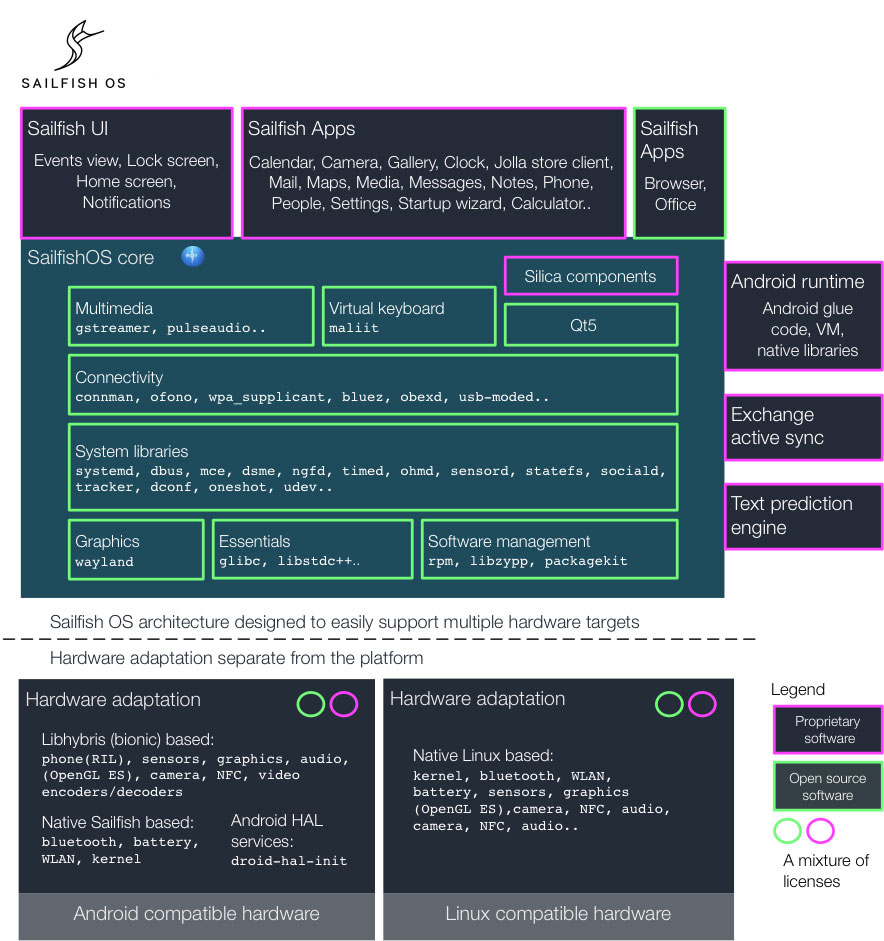Info
Sailfish OS history
Sailfish OS’s heritage lies in Nokia times, especially in the MeeGo operating system. Prior to 2011 Nokia and Intel had a vision of an open mobile operating system. Together they invested around 1 billion USD to the project and created an open source based operating system called MeeGo, which was used as a basis for several devices, such as the iconic Nokia N9. Although the Nokia N9 became the beacon of open source operating systems, Nokia decided to end the project and chose instead to continue with Microsoft’s Windows Phone OS. The rest of that is another story.
The passionate team behind MeeGo refused to quit working on the project they’ve believed in. They, or currently ‘we’ saved MeeGo by setting up a new company, Jolla Ltd., to develop the swipe-based MeeGo into the flowing user experience that is Sailfish OS. We quickly enhanced Sailfish OS to run Android apps and it became hardware compatible with Android chipsets. In November 2013, we launched the beta version of Sailfish OS to the market with the Jolla smartphone. Shortly after this, we released Sailfish OS version 1.0 and the first Sailfish OS product, the Jolla smartphone entered 36 markets during one year. In 2015, Sailfish OS 2.0. was released along with the Jolla Tablet, and a strengthened focus on the company’s licensing strategy.
In 2018 Sailfish OS matured to its third generation offering a packetized, secure solution for various corporate and governmental environments, and a smooth and secure mobile OS for tech-savvy consumers through the Sailfish X community program. The fourth generation, Sailfish 4, introduced in February 2021, boasts a multitude of new enablers to support different ecosystem projects, be it private corporate solutions or public sector governmental deployments.
Why Sailfish OS?
Sailfish OS is a mature mobile OS platform; it has been on the market since 2013, it has been market-proven on several mobile devices, and it is being deployed in many mobile ecosystem projects around the world. It is the only open source based and independent mobile OS without any ties to big corporations, supported with strong IPR including full IP rights and trademarks.
Sailfish OS is developed by Finnish mobile company Jolla by a team of efficient and high-skilled engineers working together since 2011. The Jolla team is supported by a worldwide Sailfish community contributing to the open source codebase. With a strong, respected, and award-winning brand and reputation, Sailfish OS is a perfect strategic solution for corporations and governments, and a sought-after OS for mobile enthusiasts looking for an alternative.
OS architecture
Sailfish operating system is built like a classic Linux distribution. The signature Sailfish UI has been developed by Jolla using QML, a powerful user experience design language provided by Qt framework. The QML language and features give Sailfish OS the ability to provide a rich set of UI elements, to create animated, touch-enabled UIs and lightweight applications. Jolla has created the UI building blocks to build native applications with custom components called Sailfish Silica.
Sailfish OS also includes the capability to run Android™ applications. It is based on Android libraries, ensuring performance comparable to the native environment.
With Sailfish using Qt5 and Wayland technology, existing hardware adaptations made for Android can be leveraged, significantly easing the hardware adaptation work required to support the OS.
If you are interested in Open Source software part, you can download source code from here.
